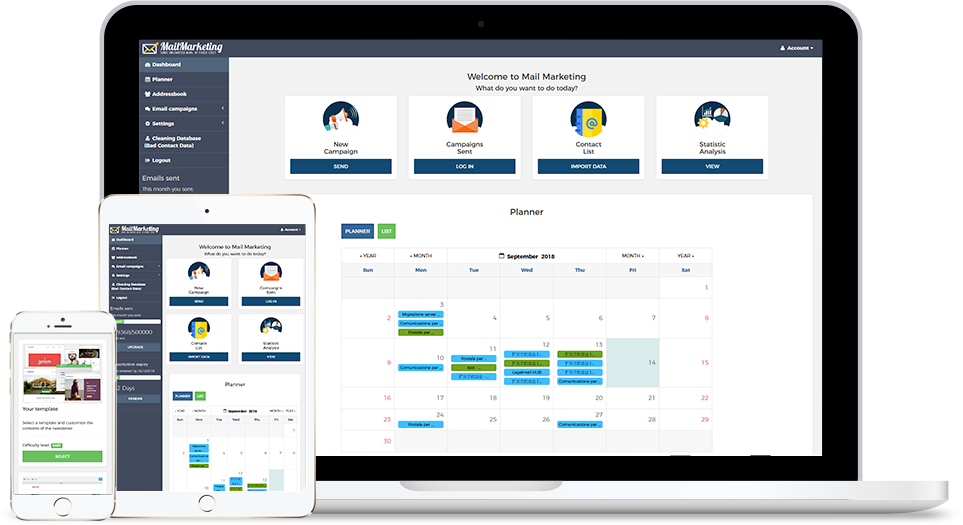There may be several reasons why emails are not delivered or end up in junk mail. Let's look at the main Cases and their respective Solutions together
There are hundreds of companies, businesses, bloggers who daily use MailMarketing.com to send emails to their customers, prospects and subscribers. Some of them contact us asking the same question: "Why do some emails not reach their destination?"
There are many different reasons why messages have not been sent or delivered or end up in junk mail.
Let's see together some of the main cases and how to find the most suitable solution to each problem.
1) Why the emails have not been sent?
There are three reasons why emails have not been sent:
- Your campaign was planned for a future date or is in draft but has not been sent.
- Your campaign is still in the sending phase, but the sending has not been completed. Campaigns that are being sent are indicated by the "hourglass" icon.
- You do not have the number of emails needed to send that campaign. If you do not have enough mailings, please upgrade your subscription or purchase the necessary mailings as a wild card.
2) Why the emails have not been delivered?
When talking about undelivered emails, a distinction must be made between emails that are not delivered to the recipient's inbox and emails that are delivered but end up in SPAM instead.
There are two types of undelivered emails and they are grouped under the label "Hard Bounce" and "Soft Bounce".
a) Hard Bounce
The email is classified in Hard Bounce when it is sent to an address that does not exist or has been closed, for example the most common case is when it is associated with a site that is no longer online. Sending emails to contacts with Hard Bounce reduces the delivery rate both because of an easily understandable element, if the addresses no longer exist you will never be able to reach them, and because "inactivity" of these recipients affects more widely the deliverability even to active emails.
MailMarketing.com has a preventive system that automatically blocks contacts that return a hard bounce and no longer allows them to be sent. In the bad contact data section you will find all the addresses for which a hard bounce status has occurred, check that there are no emails among these contacts simply mistranslated. For emails that are not actually active, it is advisable to remove them.
b) Soft Bounce
Soft bounces are messages that are temporarily rejected, usually due to problems with the recipient's mailbox or server (for example, the mailbox is full or the server is down). The email may be stored on the recipient's server and delivered later, or the sender's email program may try to deliver it again. The soft bounce is therefore about a temporary unavailability of the email address and therefore the contacts will not be considered as "bad contact data" but will remain available for subsequent mailings.
There are also cases where some soft bounces become hard bounces, for example when the recipient has an email on Yahoo, Free or Hotmail. These providers may have temporary technical problems and it can take up to twenty-four hours for the email to be delivered, Mail Marketing will make several attempts to deliver it. After 5 soft bounces, the error becomes hard bounce and the contact will end up in bad contact data.
3) My message has ended up in SPAM. Why?
The last case where the email does not reach the recipient is that it is sent and delivered correctly to the recipient's email inbox but ends up in SPAM. One of the main reasons why emails arrive in spam is that the anti-spam policies of email service providers (GMAIL, Yahoo!, Hotmail, Free, etc.) are becoming increasingly strict.
The reasons why your emails might go into SPAM are mainly
- The origin of Email (IP)
- The sender's reputation
- The content of the email (use of certain words in the subject line or text of the email)
- Engagement of recipient
In order to avoid ending up in SPAM, you must pay attention to the quality of your communications, the choice of your recipients and the interaction they will have with your messages.
BONUS: 10 Tips to improve email delivery rates
- Implements DNS-based domain authentication protocols such as SPF and DKIM to increase reliability with Email Service Providers such as Gmail, Hotmail, Yahoo! (available on request).
- Send only to contacts who have given their consent.
- Keep your database clean, delete bad contact data.
- Pay attention to the use of certain terms in the subject line and text of the email, such as "free", "gift", and replace characters such as £ and % with their word equivalent ("pounds" and "percentages").
- Optimize subject line, text per image ratio, alt text per image and send time.
- Evaluate the possibility of a dedicated SMTP to completely and independently manage your reputation and improve delivery times (available on request).
- Avoid using URLs as displayed text (anchor text).
- Invite people to add you to the white list, i.e. in their contacts' address book.
- Invite people to move you from SPAM to inbox.
- Constantly monitor Engagement metrics after each campaign and check which elements bring better results.
MailMarketing.com users can request support via the contact form for SPF configuration and DKIM for sender certification or request the installation of a personal SMTP.


